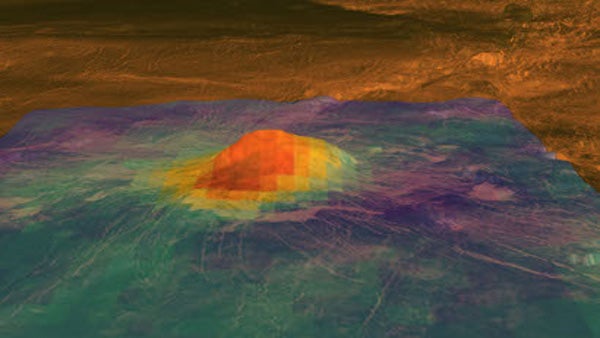The European Space Agency’s (ESA) Venus Express has returned the clearest indication yet that Venus is still geologically active. Relatively young lava flows have been identified by the way they emit infrared radiation. The finding suggests that the planet remains capable of volcanic eruptions.
Scientists have long recognized that there are simply not enough craters on Venus. Something is wiping the planet’s surface clean. That something is thought to be volcanic activity, but the question is whether it happens quickly or slowly. Is there some sort of cataclysmic volcanic activity that resurfaces the entire planet with lava, or a gradual sequence of smaller volcanic eruptions? New results suggest the latter.
“Now we have strong evidence right at the surface for recent eruptions,” said Sue Smrekar from NASA’s Jet Propulsion Laboratory in California.
That strong evidence comes in the form of compositional differences compared to the surrounding landscape in three volcanic regions. The Visible and Infrared Thermal Imaging Spectrometer (VIRTIS) collected the data on ESA’s Venus Express spacecraft, which has been orbiting the planet since April 2006.
VIRTIS records the brightness of surface rocks, providing an estimate of “emissivity.” In 2008, Joern Helbert and Nils Mueller, Institute of Planetary Research, German Aerospace Center, Berlin, published a map of the variation of infrared emissivity across the southern hemisphere of Venus.
Smrekar and her colleagues targeted three regions that geologically resemble Hawaii, well-known for its active volcanism. They show that the regions on Venus have higher emissivities than their surroundings, indicating different compositions. On Earth, lava flows react rapidly with oxygen and other elements in the atmosphere, changing their composition. On Venus, the process should be similar, though more intense, because of the hotter, denser atmosphere chiefly made up of carbon dioxide.
The researchers interpret the fact that the lava flows appear to have different compositions from their surroundings as being evidence of a lack of surface weathering, indicating that the flows erupted relatively recently. They estimate that the flows are possibly as geologically recent as 2.5 million years — and likely much less, possibly even currently active. “This is a significant result,” said Hakan Svedhem, ESA Venus Express project scientist.
While the gradual resurfacing scenario might not be the most spectacular, it does make Venus look a little more earthlike.
“There are some intriguing models of how Venus could have completely covered itself in miles of volcanic lava in a short time, but they require the interior of Venus behaving differently from Earth,” said Smrekar. “If volcanism is more gradual, this implies that the interior may behave more like Earth, though without plate tectonics.”










